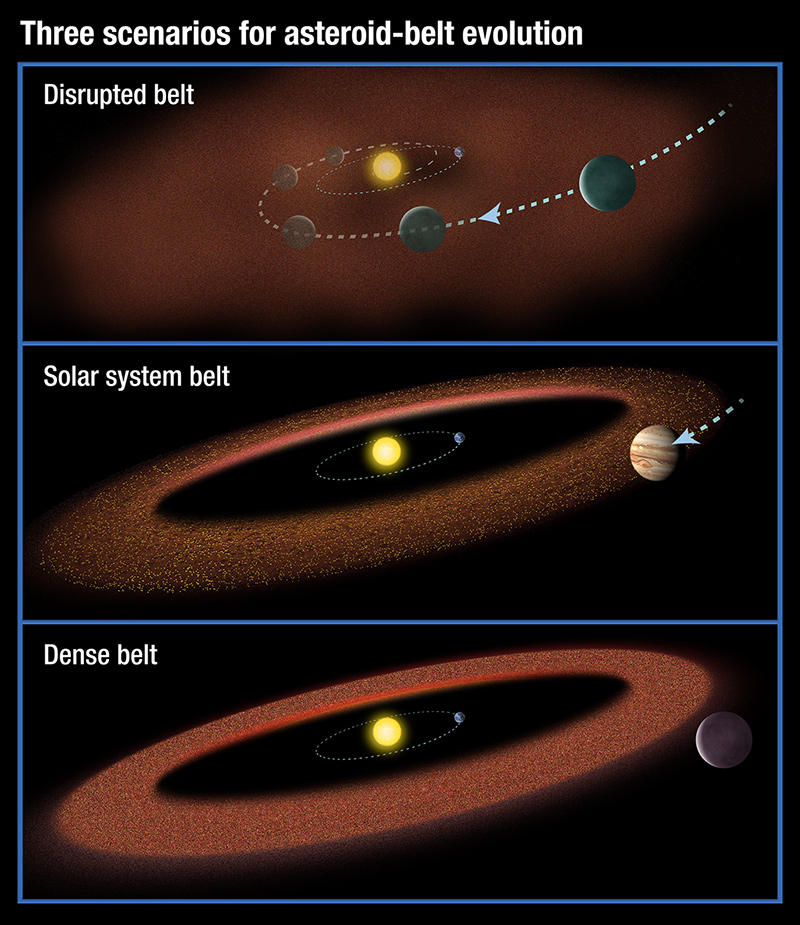We're open daily! View holiday hours
Science News
Life Near the Asteroid Belt
November 9, 2012

What planetary conditions does life require to evolve? Astronomers ask this question often as they search the Universe for a place like Earth. Water seems to be a necessity. So does maintaining the right distance from a parent star (think habitable zone). What about an asteroid belt?
Two researchers hypothesize that an asteroid belt, just the right size and distance from its star, might be necessary for a star system to support a life-bearing planet.
This might sound surprising, since asteroids can occasionally impact Earth and trigger mass extinctions. Ouch! But an emerging view proposes that asteroid collisions with planets may provide a boost to the birth and evolution of complex life.
For one thing, asteroids delivered water and organic compounds to the early Earth. Consistent with the theory of punctuated equilibrium, occasional asteroid impacts might also accelerate the rate of biological evolution by disrupting a planet’s environment to the point that species must evolve new adaptation strategies.
Rebecca Martin, of the University of Colorado, and Mario Livio, of the Space Telescope Science Institute, looked at our solar system and used theoretical models and actual observations of other star systems and exoplanets to study the theory that life needs an asteroid belt.
They suggest that the location of an asteroid belt relative to a Jupiter-like planet is particularly favorable to life. The asteroid belt in our solar system, located between Mars and Jupiter, is a region of millions of space rocks sitting near the “snow line,” beyond which volatile materials such as water ice are far enough from the Sun’s heat to remain intact.
Our solar system’s formation was just right for life, Livio says. “To have such ideal conditions you need a giant planet like Jupiter that is just outside the asteroid belt [and] that migrated a little bit, but not through the belt,” he explains. “If a large planet like Jupiter migrates through the belt, it would scatter the material. If, on the other hand, a large planet did not migrate at all, that, too, is not good because the asteroid belt would be too massive. There would be so much bombardment from asteroids that life may never evolve.”
Using our solar system as a model, Martin and Livio proposed that asteroid belts in other solar systems would always be located approximately at the snow line. They created models of protoplanetary disks, the dense gas and dust around a newly formed star; then they looked at observations from NASA’s Spitzer Space Telescope of 90 such regions that have warm dust, which could indicate the presence of an asteroid belt-like structure. The warm dust fell right near the snow line.
But for life to exist, the system also needs a large gas giant, like Jupiter, to “manage” the size of the asteroid belt. So Martin and Livio looked at data for 520 giant planets found outside our solar system. Only 19 of them reside outside the snow line, suggesting that most of the giant planets that formed outside the snow line have migrated too far inward to preserve the right-sized asteroid belt needed to foster life on an Earth-like planet near the belt. The team calculated that less than four percent of the observed systems may actually harbor such a compact asteroid belt.
“Our study shows that only a tiny fraction of planetary systems observed to date seem to have giant planets in the right location to produce an asteroid belt of the appropriate size, offering the potential for life on a nearby rocky planet,” says Martin. “Our study suggests that our solar system may be rather special.”
Their findings are published in the Monthly Notices of the Royal Astronomical Society: Letters.
Image: NASA, ESA, and A. Feild (STScI)